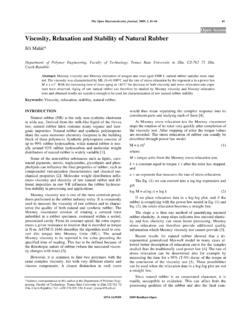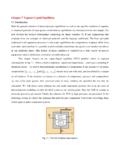Transcription of Mechanics of Soft PSAs (Pressure Sensitive Adhesives)
1 Send Orders for Reprints to The Open Materials Science Journal, 2013, 7, 23-28 23 1874-088X/13 2013 Bentham Open Open Access Mechanics of soft PSAs (Pressure Sensitive Adhesives) Giuseppe Lamanna*,1 and Alessandro Basile2 1 Department of Industrial and Information Engineering, Second University of Naples, Italy 2 Bridgestone Technical Center Europe SpA, Rome, Italy Abstract: The adhesive performances of a PSA (Pressure Sensitive Adhesive) are attributed to their viscoelastic properties.
2 In this paper we analyze the viscoelastic behavior of different PSAs having substantially similar adhesive performance. Linear and non linear analyses were performed using small amplitude oscillatory shear tests and tensile stress-strain tests, respectively. It is shown that linear viscoelastic tests are useful to qualitatively characterize the adhesive performances. However, deeper knowledge can be achieved by non linear viscoelastic tests. The true stress - true strain curves are modeled by using a theory accounting for the interpenetration of micro-network and the linear polymer. It is shown that the same substantial in-service properties can be achieved with adhesives showing different fingerprints in terms of viscoelastic spectra.
3 Keywords: Pressure Sensitive adhesives, tack, shear resistance, peel strength. INTRODUCTION Pressure Sensitive Adhesives PSAs are viscoelastic-elastomeric materials, combining simultaneously a liquid-like character to form good molecular contact upon application of light pressure in a short contact time, and solid-like character to resist to an applied stress once the bond has been formed [1-7]. The engineering performances of the adhesives under concern are determined by three non-standard measure-ments, that quantitatively ascertain their tackness, shear holding power and the peel resistance.
4 The adhesive tackness is measured by registering the force per unit area required to pull apart the adhesive and the backing previously subjected to low compressive forces in a small time interval. The shear resistance characterizes the behavior of the PSAs under the influence of long lasting stresses [8-13]. The peel strength is a measure of the debonding process and depends from the test geometry, temperature, adhesive thickness and nature of the backing [14-19]. Generally the properties of PSAs are related to their linear viscoelastic properties [20-22] but in reality the adhesive performances involve large strains which cannot be predicted easily by small stress/strain responses, creep or stress relaxation or by small amplitude oscillation tests [23-26].
5 The chemical nature [23, 24] and the thickness of the adhesive influence the adhesive performances as well as the surface conditions of the adherent including roughness and surface tension. In fact the surfaces of tape and backing and the bulk properties of adhesives effects are coupled and it *Address correspondence to this author at the Department of Industrial and Information Engineering, Second University of Naples, Italy; Tel: +39 081 5010 295; Fax: +39 081 5010 412; E-mails: would be more accurate to consider adhesive/substrate pairs than adhesives and substrates separately. Nonetheless, given the nature of the backing and the tape, this paper deals with the characterization of the bulk viscoelastic properties of two different adhesives, the work being addressed to the correlation between small strain oscillatory experiments and the stress-strain responses and eventually their influence on in-service properties.
6 Adhesion and tack of polymers are not fundamental material properties like the elastic modulus or the viscosity. They strongly depend on the test methods and the conditions of measurement. The adhesion performance is characterized by the adhesive fracture energy that is determined under well-defined conditions of bond formation and bond separation. Zosel [2, 11] developed an instrument that measures fracture energy and studied the deformation behavior during bonding and debonding. It was shown that the adhesion and tack are connected with the glass transition range of the polymer.
7 The adhesive fracture energy exhibits a maximum in the temperature range above the glass transition region. In this temperature range, the mechanical behavior is determined by intermolecular interactions, so-called entanglements that form a network of temporary cross-links. High tack values require a good deformability of the polymer, a sufficiently low modulus, and that means the material must have an entanglement network with long chain molecules between two entanglements. For instance, the formation and growth of fibrils during debonding seems to be crucial to the peel strength (the index of the resistance to bond separation) and the tackiness of polymers used as pressure- Sensitive adhesives.
8 Zosel [13, 19, 26] studied the influence of a number of parameters such as contact force and time, surface roughness, temperature, and rate of separation on fibrillation, to establish relations between the nucleation and growth of fibrils and the mechanical behavior as well as the molecular structure of the 24 The Open Materials Science Journal, 2013, Volume 7 Lamanna and Basile adhesives. Measurements of a large number of model polymers lead to the conclusion that the average mass between entanglements, Me, is an important factor governing fibrilation.
9 Polymers with a high Me above about 1 104 g/mol show fibrilation whilst materials with an entanglement length below this limit debond by an apparently homogeneous deformation with lower-energy dissipation. However, Pressure Sensitive Adhesives contain some gel fractions (sometimes being the predominant amount of the mixture), dispersed in micro-domains somewhat entangled to the un-crosslinked phase. Despite the complexity of peeling process, where the peel strength is generally dominated by large energy dissipation due to fibrils formation, it is frequently reported that the performances of PSAs can qualitatively be correlated to a selected window of their linear viscoelastic spectrum [17-20].
10 Instead, the peeling performances of PSAs subtend a rather high strain and strain rate process where the fibrils formation is generally preceded by cavitation phenomena [20-28], the formation of spherical voids inside the adhesive. The cavitation phenomenon is completely dominated by bulk relaxation modulus of the adhesive and arises due to the plain strain conditions that hold during the peeling just behind the peeling front. In many instances these phenomena dominate also in structural adhesives even if they lay in their glassy state [29-42]. Indeed, the intensity of the three-dimensional stress state during peeling is strongly dependent on the flexural stiffness of the tape, once the surface properties of the backing and the tape (namely, the roughness and the surface tension) and the adhesive thickness are established.















